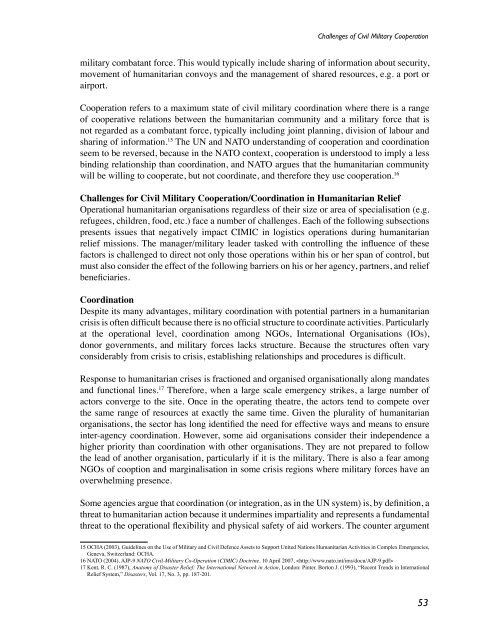Defence Forces Review 2010
Defence Forces Review 2010
Defence Forces Review 2010
You also want an ePaper? Increase the reach of your titles
YUMPU automatically turns print PDFs into web optimized ePapers that Google loves.
Challenges of Civil Military Cooperationmilitary combatant force. This would typically include sharing of information about security,movement of humanitarian convoys and the management of shared resources, e.g. a port orairport.Cooperation refers to a maximum state of civil military coordination where there is a rangeof cooperative relations between the humanitarian community and a military force that isnot regarded as a combatant force, typically including joint planning, division of labour andsharing of information. 15 The UN and NATO understanding of cooperation and coordinationseem to be reversed, because in the NATO context, cooperation is understood to imply a lessbinding relationship than coordination, and NATO argues that the humanitarian communitywill be willing to cooperate, but not coordinate, and therefore they use cooperation. 16Challenges for Civil Military Cooperation/Coordination in Humanitarian ReliefOperational humanitarian organisations regardless of their size or area of specialisation (e.g.refugees, children, food, etc.) face a number of challenges. Each of the following subsectionspresents issues that negatively impact CIMIC in logistics operations during humanitarianrelief missions. The manager/military leader tasked with controlling the influence of thesefactors is challenged to direct not only those operations within his or her span of control, butmust also consider the effect of the following barriers on his or her agency, partners, and reliefbeneficiaries.CoordinationDespite its many advantages, military coordination with potential partners in a humanitariancrisis is often difficult because there is no official structure to coordinate activities. Particularlyat the operational level, coordination among NGOs, International Organisations (IOs),donor governments, and military forces lacks structure. Because the structures often varyconsiderably from crisis to crisis, establishing relationships and procedures is difficult.Response to humanitarian crises is fractioned and organised organisationally along mandatesand functional lines. 17 Therefore, when a large scale emergency strikes, a large number ofactors converge to the site. Once in the operating theatre, the actors tend to compete overthe same range of resources at exactly the same time. Given the plurality of humanitarianorganisations, the sector has long identified the need for effective ways and means to ensureinter-agency coordination. However, some aid organisations consider their independence ahigher priority than coordination with other organisations. They are not prepared to followthe lead of another organisation, particularly if it is the military. There is also a fear amongNGOs of cooption and marginalisation in some crisis regions where military forces have anoverwhelming presence.Some agencies argue that coordination (or integration, as in the UN system) is, by definition, athreat to humanitarian action because it undermines impartiality and represents a fundamentalthreat to the operational flexibility and physical safety of aid workers. The counter argument15 OCHA (2003), Guidelines on the Use of Military and Civil <strong>Defence</strong> Assets to Support United Nations Humanitarian Activities in Complex Emergencies,Geneva, Switzerland: OCHA.16 NATO (2004). AJP-9 NATO Civil-Military Co-Operation (CIMIC) Doctrine. 10 April 2007, 17 Kent, R. C. (1987), Anatomy of Disaster Relief: The International Network in Action, London: Pinter. Borton J. (1993), “Recent Trends in InternationalRelief System,” Disasters, Vol. 17, No. 3, pp. 187-201.53
















